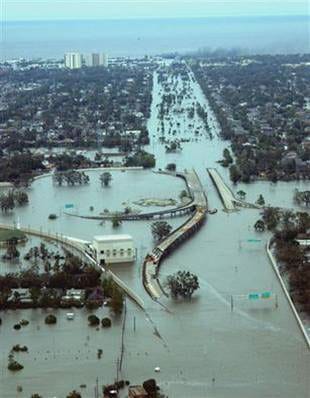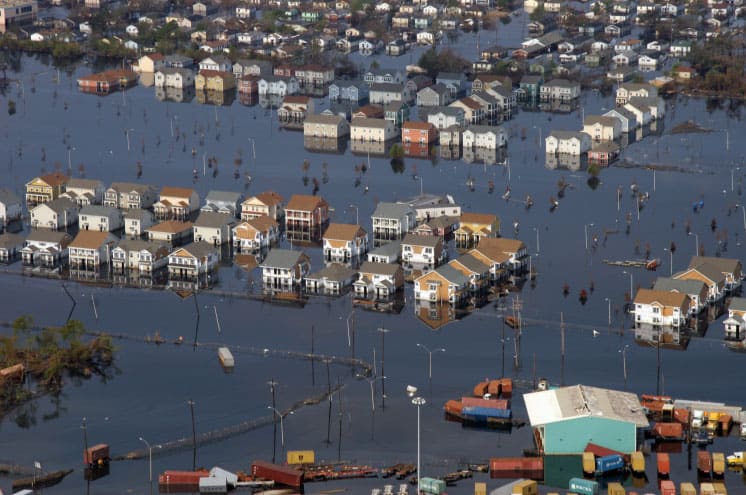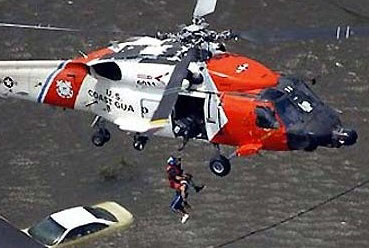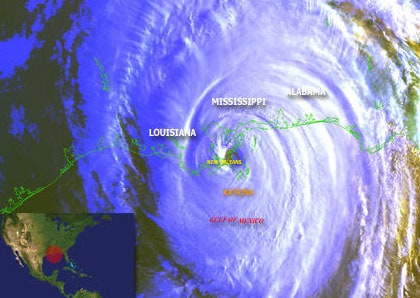 Hurricane Katrina, one of the largest natural disasters in our nation’s history, was chosen for inclusion in the Coast Guard Aviation History Timeline because it illustrates both the capabilities of the United States Coast Guard and its operational principles that promote leadership, accountability, and delegation of authority to qualified personnel at the lowest possible level, facilitating rapid response and maximizing effectiveness in dynamic environments. The result is an exceptional high standard of performance.
Hurricane Katrina, one of the largest natural disasters in our nation’s history, was chosen for inclusion in the Coast Guard Aviation History Timeline because it illustrates both the capabilities of the United States Coast Guard and its operational principles that promote leadership, accountability, and delegation of authority to qualified personnel at the lowest possible level, facilitating rapid response and maximizing effectiveness in dynamic environments. The result is an exceptional high standard of performance.
The Coast Guard played a key role in the planning, response and recovery efforts for Hurricane Katrina in three mission areas: search and rescue, maritime pollution response, and management of maritime commerce. This narrative addresses the search and rescue response and is primarily focused on the aviation response.
Katrina formed over the Bahamas on August 23, 2005, then crossed southern Florida as a moderate Category 1 hurricane and strengthened rapidly in the warm waters of the Gulf of Mexico. Hurricanes are a fact of life along the Gulf Coast and the Eighth Coast Guard District has in place a response plan that is regularly exercised and adjusted when needed. As Katrina approached the central coast RADM Robert Duncan, Commander CGD8, authorized the evacuation of dependents and relocated elements of the District Staff from New Orleans, Louisiana to St. Louis, Missouri. Warnings were broadcast to mariners and the offshore community. District aircraft and surface units were pre-positioned to places which insured their survival and their ability to respond immediately as per the District Commander’s intent. Liaison was established with state and local authorities and the Atlantic Area Commander was regularly appraised of the situation and possible assistance required.
Atlantic Area Operations Forces, CAPT Neil Buschman, had been monitoring the storm since formation as a tropical depression and coordinated potential asset requirements with the District Commanders – this was initially CGD7 — and when the storm, which was initially forecast to cross over Florida as a Category 1 and dissipate, began to intensify in the Gulf of Mexico, CGD8 came into the picture. As Katrina intensified to Category 3 preparations to supplement CCG8 assets began. As Katrina became a Category 4 storm, and then for a short period grew to a category 5, it became apparent that a large response would be necessary. Preparation normally goes through four phases, each with an increased number of assets. Certain assets are Area controlled and others by the District. Aviation forces asset availability is coordinated with the District OSR and the Air Stations because of minimum SAR requirements and the fact that the aviation assets are first responders. CAPT Steve Taylor, Aviation and Force Manager Atlantic Area, stated that by Sunday the 28th the response had become a maximum effort. The District Commanders gave everything they could and still maintain minimum SAR. LANTAREA, Vice Admiral Vivian Crea, authorized the temporary suspension of OBAT to provide more helicopter aircraft. Both Captain Buschman and Captain Taylor alluded to the fact that aviation units are pro-active and as a result began phasing for deployment on the 28th to pre-position themselves so that they would be on scene and operational as soon as possible after hurricane passage.
Katrina was upgraded to Category 5 at 7:00 am on the 28th and was projected to hit in the New Orleans area. The Coast Guard air station at New Orleans evacuated its five HH-65 helicopters in the early afternoon – three to Lake Charles and two to Houston. ATC Mobile evacuated aircraft to HITRON facilities at Cecil Field Jacksonville. The Hurricane came ashore, on the morning of the 29th, just east of the Mississippi River as a Category 4 hurricane with weakening winds. The New Orleans helicopters were airborne in the late morning for Houma, 35 miles southwest of New Orleans, so as to be in position to render assistance as soon as the weather permitted. When the winds reduced to 60 kts, the maximum wind that the helicopters could turn the rotor for starting, two helicopters launched and proceeded to Venice via Grande Isle and then northbound up the river. There are a lot of small towns that line the river and a lot of people. The pilots reported utter devastation: houses were shredded into bits; boats were everywhere up on top of the levee, on top of bridges, and in the woods; heavy flooding; homes under water; and people in distress. The first of the rescues was at 2:50 that afternoon and they continued on into the night. The remaining three helicopters launched shortly thereafter for New Orleans via the Coast Guard air station located at the Joint Reserve Air Base, New Orleans. They were over the city shortly after 16:00 and rescues commenced and continued through the night. Five Houston HH-65 helicopters arrived at the New Orleans air station that evening and began rescue operations.
ATC Mobile aircraft commenced the return shortly after noon but had to make intermittent stops due to the strong weather bands on the east side of the hurricane. They arrived at Mobile in the late afternoon. Rescue operations commenced immediately along the Alabama–Mississippi Coast and on into New Orleans. Mobile operations also continued on through the night. Others began to arrive. Within 12 hours after landfall a quarter of the Coast Guard’s entire helicopter fleet were conducting rescues over New Orleans and the Mississippi coast. – An amazing feat. – The number of aircraft and crews continued to increase during the next two days.
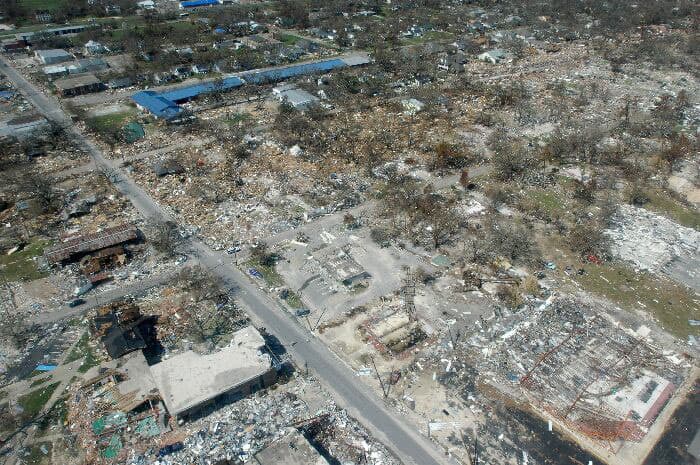
Mississippi suffered extensive damage. Although the storm had weakened the wind driven storm surge peaked at 28 feet at landfall because of large waves, in excess of 30 feet, that were generated when Katrina was a Category 5 storm. The city of Biloxi was decimated; major east west highways in southern Mississippi became impassable due to storm debris; downtown Gulfport was under 10 feet of water and structures flooded for miles inland; Waveland was devastated leaving no inhabitable structures; and communications infrastructure was described as non-existent. Alabama also suffered significant damage resulting in large amounts of debris.
New Orleans sustained far reaching damage as the hurricane passed to the east on the morning of August 29. Many high-rise buildings suffered blown out windows, while roof sections of the Louisiana Superdome, where over ten thousand people had sought shelter, were stripped away. The storm surge, extreme amounts of rain, and high winds stressed the city’s extensive levee system. The levee on the 17th street canal gave way shortly after 9:00 am and the city began to flood. This was followed by 28 additional breeches over the next 24 hours. It was these breeches and overtoppings of the levee system that flooded the city and turned a severe hurricane into a disaster of catastrophic proportions. The New Orleans primary and secondary power sources were lost rendering the pumping stations, which could have prevented some of the flooding, inoperative. There was also widespread destruction of the communications infrastructure which made it extremely difficult for state and local responders to effectively evaluate or address the situation.
Both the New Orleans air station and ATC Mobile sustained hurricane damage; New Orleans much more severe than Mobile. At New Orleans there was heavy damage to the hangar and attached buildings. All of the locker rooms, maintenance office spaces, maintenance shops, crew lounge, eating area, and the berthing area were rendered unusable by flooding which took place because the roof pealed back on the hangar and surrounding buildings. With no berthing area on-board station personnel slept on cots and the floor of the administration building. Limited electrical power was provided by an auxiliary generator and there was no air conditioning. For the first seven days Air Station New Orleans personnel subsisted on bottled water and packaged Meals Ready to Eat (MRE’s) flown in by Coast Guard C-130’s. The ramp area, however, was serviceable. Mobile lost part of the hangar roof and the operations center. Initially communications consisted of satellite phone and limited cell phone availability. The rest of the buildings were damaged but serviceable.
Air Station New Orleans is eight air miles south of the center of the city – well within the rescue area – and thus became the forward operating base. ATC Mobile, 50 minutes flight time to the east of New Orleans served as the major staging area, force provider and maintenance facility for aircraft and crews that were cycled continuously to and from the New Orleans area. In addition ATC Mobile had rescue responsibility for the Alabama and Mississippi area. Almost all airborne rescue operations in the Mississippi area were completed within 36 hours of Katrina’s landfall as the Mississippi first responder infrastructure worked well. The Mississippi National Guard, police, and fire personnel were on scene rapidly and coordination between these units and the Coast Guard allowed for quicker completion of the rescue mission.
Tactical control was shared between ATC Mobile and CGAS New Orleans. Aircraft and supplemental crews from air stations around the country operated out of Mobile. They received
initial tasking at Mobile. Those assigned to the New Orleans area would refuel at CGAS New Orleans, debrief, eat and then tasked by CGAS New Orleans based on updated information. The NAS fuel facilities were made operational by Coast Guard technicians and additional fuel was flown in by Coast Guard C-130 aircraft. The missions were scheduled for six hours and at the end of scheduled mission time the helicopters would return to Mobile and debrief. The crews would be replaced by fresh crews who had been briefed and tasked and the helicopters again departed for the New Orleans area. The operations ran 24/7. The three training branches HH-60, HH-65 and HU-25 became operations and scheduling for their respective aircraft. Captain David Callahan, Commanding Officer of ATC Mobile said the debrief, brief and tasking were conducted in a make shift operations building using white boards in a manner that was similar to that used during World War II. By the third day 43 aircraft and 2000 personnel had arrived at ATC Mobile. Personnel slept on cots wherever space could be found and base support personnel did an outstanding job in feeding that number using facilities designed to support far fewer.Viewed from the air the city of New Orleans was a shocking sight of utter destruction. Vast stretches of the city resembled a community of houseboats. Twenty-block neighborhoods were under water as high as the roofs of the houses. People were everywhere; on top of houses, on the roofs of apartment buildings and the balconies of high-rises. Some were in trees and others on the tops of submerged vehicles. During daylight people waved anything that would attract attention, wrote messages on roofs, large sheets of plywood or any cardboard they could find. At night they used flashlights to draw attention resulting in a thousand twinkling lights against a black background. Most helicopter hoists, made in obstacle-strewn environments over power lines and downed trees, challenged both pilots and hoist operators to his or her limits. Nighttime operations were conducted using night vision goggles. Daytime operations were conducted in temperatures in the high nineties with the humidity in the 90 percentile; often in power limited HH-65B aircraft. When the helicopters refueled at New Orleans between sorties the pilot and co-pilot would switch seats to compensate for the strain of holding rock solid hovers and operating the aircraft on its margin all the time in the worst possible environmental conditions.
A HH-60J with three external fuel tanks can fly for 6 hours. It is designed to carry 8 survivors but when required can double that figure. The HH-65B helicopters could fly for about 2 and one half hours with a designed capacity of three adult survivors. The problem was that in the existing temperature and humidity conditions the helicopter could not lift this number with a full fuel load. The position of CGAS New Orleans within the rescue area allowed for sorties to be flown with reduced fuel loads enabling a space limited number of survivors to be picked up without a fuel burn-off. There were only three HH-65Cs with the more powerful engines. These helicopters could be launched with a full fuel load, had an additional thirty minutes on scene and could hoist the designed capacity plus additional survivors without fuel load compensation. By the end of 2007 all HH-65 helicopters had been up graded to the C model.
There was an urgency felt by all crews to continue rescuing a seemingly endless supply of increasingly desperate survivors as the dark nights and hot days wore on. It was a sustained maximum effort that was possible only because of the Coast Guard’s standardized organizational structure based on sound operation principles coupled with standardized training. This makes possible the mixing of personnel and assets from anywhere in the country to form highly competent operational response teams. CAPT Jones addressed the subject this way: “The fact that you can take a rescue swimmer from Savannah and stick him on a helicopter from Houston with a pilot from Detroit and a flight mech from San Francisco, and these guys have never met before and they can go out and fly for six hours and rescue 80 people and come back without a scratch on the helicopter is something no other agency, commercial or DOD, can do.”
The conditions encountered by rescue swimmers included flooded houses and buildings; steep slippery roofs; submerged and hidden objects; and water contaminated with sewage, chemicals, and fuel oil leakage. Rescues were made by basket and by strop which is a webbing and stainless steel harness that fits under the arms with a crotch strap to keep the survivor from falling out of the harness. The rescue swimmer would hook his harness plus the strop harness to the hoist cable and signal the hoist operator to winch them up. Fear and panic can be obstacles. Some people would yell and scream when they realized there was nothing below them and they were suspended by a wire rope. “You just hold on to them and tell them it is going to be OK,” said Coast Guard swimmer Josh Micheltree.
On the first day of rescue operations AST2 Joel Sayers was lowered onto a rooftop to rescue an older woman stranded by the rising floodwater. The noise and constant downward pressure coming from the helicopter was familiar but the sloped roof and flying shingles were a new experience. When he landed, Sayers began talking to the frightened woman and learned that her husband was still in the attic of their house, unable to move. Sayers looked through the small opening in the roof the woman had managed to escape through and saw the woman’s husband. After several failed attempts to widen the hole and free the man using the helicopter’s crash ax, Sayers knew he needed something with more weight and strength if he was to save the man trapped inside. Sayers looked through the hole in the roof and promised the man he would come back to get him. Sayers tied a brightly colored piece of cloth around one of the house’s vent pipes to identify it because even with Global Positioning System everything looked the same. He then convinced the wife she had to — at least for now — leave her husband behind. With the wife aboard the helicopter proceeded to a drop off point with a fire truck present and a fire axe was obtained. The helicopter and crew returned to the house with the wife on board. Sayers was again lowered to the roof, looked through the hole, asked the husband to back away and began to chop a hole large enough to get him out. Once the man was removed from the attic he was hoisted into the helicopter and reunited with his wife.
The incident was debriefed and immediately Coast Guard personnel from ATC Mobile contacted the managers of the closed Lowes and Home Depot stores in the area and made arrangements to purchase all of the axes, and gasoline powered do-all and small chain saws they had. The purchase was paid for by unit credit card. All helicopters were thereafter equipped with axes and/or power saws. In the days to come the rescue swimmers found that many people had gone to the attics to escape the flood and had no way to get out. The swimmers would mark the roof with a large X after it was ascertained that there were no survivors left inside.
Mayor Nagin predicted that there would be 10,000 lives lost. The final count was 964 directly attributed to the storm. There were a number of reasons for this difference such as the rapid response of the Coast Guard, its ability to adjust to the situation, and in a very real sense the proficiency and ability of the rescue swimmers who came in direct contact with the survivors. The swimmers would set priorities and determined who needed immediate evacuation. A disabled person in a wheelchair or a diabetic or the elderly would go out first. Next would be the mothers with small children and the able bodied would have to wait a day or two. In addition the swimmers would find or designate a man in charge who was tasked with organizing the survivors. It happened many times that the person in charge was last to leave. The swimmers interaction with those they rescued was superb.
The magnitude of the operations placed the helicopters in close proximity to each other. Traffic control was self provided using eyeballs and a common frequency much the same as small aircraft at airports without a control tower. Communications with personnel on the ground including those at hospitals and at staging areas were difficult to non-existent depending on the location of the helicopter. LT Beth McNamara, a C-130 pilot on an environmental evaluation flight during the initial response recognized this and redirected her mission within the scope of her own authority creating the first airborne communication platform in the area. Coast Guard C-130s continued to provide this service until the third day when the task was taken over by Navy E2C’s and Customs P3B’s. It was decisions like this, performed by numerous competent personnel, both aviation and surface forces, that significantly contributed to the effectiveness of Coast Guard operations.
On the second day Naval units began arriving and Rear Admiral Kilkenny USN placed H-60s and H-53s under Coast Guard control for operational mission taskings. CGAS New Orleans operations were conducted from the Coast Guard ramp and the adjacent VR-54 ramp. The aircraft mix was Coast Guard H-60s, H-65s, C-130s and Falcons, Navy and Marine Corps H-60s and H-53s and Army helicopters. CAPT Jones stated that at one point there were 70 aircraft that were being tasked. Parking and taxi control was provided by air station personnel without mishap.
The Coast Guard commands placed liaison officers with the other agencies involved in the Katrina operations in order to be cognizant of developing situations. CGAS New Orleans had liaison officers with Task Force Belle Chase as well as the National Guard’s Eagle Base, which was their massive search and rescue effort. The National Guard and the Coast Guard conducted two simultaneous search and rescue and evacuation and recovery air operations almost independently of each other. The liaison officer kept the air station briefed on what the National Guard forces were doing and what was needed. When the Eagle base people needed assistance Coast Guard aircraft and crews were provided. It was not a fully integrated air operation between Coast Guard and National Guard but it was both cooperative and effective. In fact it was the Coast Guard Liaison, LTJG Shay Williams, who planned and set up the massive air evacuation from the Convention Center to the New Orleans airport.

The effectiveness of the rescue operation would not have been possible without superb maintenance personnel and the outstanding aircraft maintenance program. Maintenance personnel from across the country instantly formed effective teams at ATC Mobile and at CGAS New Orleans and kept aircraft flying to save lives. Standardization of maintenance procedures enabled maintenance personnel to assess, repair, and maintain the same type of aircraft at any unit at any time. Helicopter support kits were supplied by CGAS Clearwater. The Coast Guard uses a computerized scheduled maintenance system, airframe specific, for scheduled maintenance which is designed to provide maximum availability of the aircraft for operational needs. Aircraft service parts supply is linked to the aircraft maintenance data base. Each morning a HU-25 would depart AR&SC and fly a round trip to Mobile, New Orleans, and Houston with high priority items.
Coast Guard Air Station Clearwater, under the command of CAPT Mike Emerson, was the hub for Coast Guard C-130 operations. The operations continued throughout Hurricane Katrina and rolled right into support for Hurricane Rita which followed. Five Clearwater C-130s were supplemented by C-130s from the Aircraft Repair and Supply Center and the Elizabeth City, Sacramento, and Kodiak air stations. Operational aircraft maintenance was performed at Clearwater.
LCDR Eric Riepe, with able assistance, scheduled the C-130 operations. A support plan, often using immediate feedback from returning sorties, was developed. LCDR Bruce Brown was comptroller and arranged for procurement of supplies and needed materials. The telephone and at times a credit card was the primary means of procurement – back-up paperwork followed when time permitted. Coordination was maintained with the Maintenance Department so that the aircraft configurations were correct for the scheduled loads. Regular reports on operations were provided to LANTAREA. (C-130s were Area assets) to provide them visibility on what was taking place.
Prior to Katrina making landfall an inventory of the CGAS Clearwater ready supply of migrant interdiction inventory which included food, diapers, lifejackets and more was made. Once Katrina made landfall the overwhelming need for not only relief supplies but supplies for first responders was recognized. The supply warehouse and hangar were delivery points for consumables. Contracts with multiple vendors in the Central/South Florida area were secured to buy bottled water by the pallet. Based upon lift capacity arrangements for delivery of up to 20 pallets per day was made and loaded directly onto waiting aircraft. Likewise thousands of MREs were procured and delivered as were blankets, diapers and other personal items. Working with a network of local churches, donations of consumables ranging from five to seven truck loads a day were received in Supply, re-packaged for air transport and loaded. In addition first responder items including heavy equipment such as forklifts, ground handling equipment and generators were flown to CGAS New Orleans and ATC Mobile.
Toward the end of the week, when the Incident Management Teams (IMT) established a footing, coordinated efforts began and often the supply schedule was rolled into an IMT requirement. It was just shy of four weeks -post Katrina- before FEMA supply lines were established to the point where Coast Guard procured/donated and delivered supplies were no longer required. The breadth of the C-130 operation and the multiple capabilities of the C-130 was demonstrated in that in addition to relief supplies the C-130s served as communications platforms, conducted surveillance missions, transported DART teams, MSST units, fuel cells, medical personnel and supplies, evacuated stretcher patients out of the area to receiving hospitals, and even 100 buoys were flown in from CGD9 for use by Sector Mobile.
The Katrina air rescue operations are but a part of a much larger story. There was CWO3 Robert Lewald who commanded the CGC Pamlico and a small fleet of vessels that safely evacuated thousands from New Orleans in what was came to be known as Operation Dunkirk. There was the small boat operation out of Zephyr Field and the DART crews that went from house to house evacuating people. And there were over 300 Coast Guard men and women from 20 different units, many of whom lost everything in the flooding, who quickly coalesced at Station New Orleans and rescued or assisted in the rescue of many. Surface personnel rescued or assisted in rescue an estimated 22,000 people over ten days in horrendous conditions with amazing displays of bravery and perseverance. – A very well done to all.

